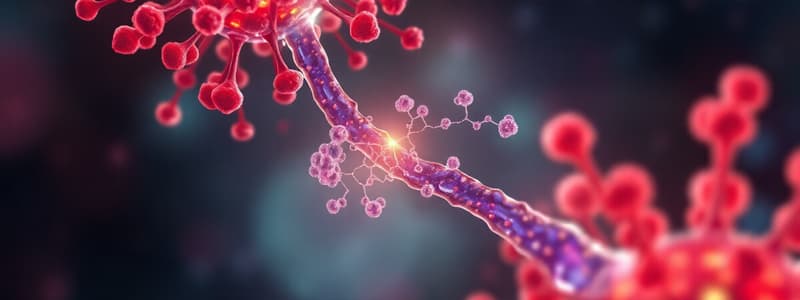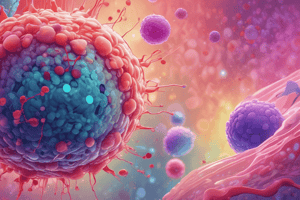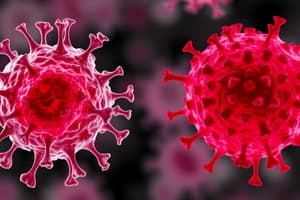Podcast
Questions and Answers
What is the primary role of the invariant chain in MHC class II molecule processing?
What is the primary role of the invariant chain in MHC class II molecule processing?
- To facilitate the transport of MHC class II molecules from the Golgi apparatus to the cell surface.
- To promote the degradation of the MHC class II molecule in the endoplasmic reticulum if it is misfolded.
- To enhance the binding affinity of MHC class II molecules to antigenic peptides in the phagolysosome.
- To prevent the binding of endogenous peptides to the MHC class II molecule within the endoplasmic reticulum. (correct)
Which of the following best describes the function of TAP (Transporter Associated with Antigen Processing) proteins in endogenous antigen presentation?
Which of the following best describes the function of TAP (Transporter Associated with Antigen Processing) proteins in endogenous antigen presentation?
- They facilitate the fusion of the endoplasmic reticulum with the Golgi apparatus.
- They transport peptides generated in the proteasome into the endoplasmic reticulum. (correct)
- They degrade cytosolic proteins into smaller peptides within the endoplasmic reticulum.
- They present lipid antigens to MHC class I molecules.
How does the immune system differentiate between intracellular and extracellular threats to initiate an appropriate immune response?
How does the immune system differentiate between intracellular and extracellular threats to initiate an appropriate immune response?
- By varying the rate of phagocytosis to match the replication speed of different pathogens.
- Through the presentation of antigens via different MHC classes, each targeting distinct T cell populations. (correct)
- By modulating the expression of co-stimulatory molecules on antigen-presenting cells based on the pathogen's origin.
- By exclusively utilizing NK cells to detect intracellular pathogens and antibodies to neutralize extracellular pathogens.
Why is the proteasome crucial in the endogenous pathway of antigen presentation?
Why is the proteasome crucial in the endogenous pathway of antigen presentation?
Considering a cell infected with a virus that inhibits phagolysosome fusion, what immune mechanism would be most effective in targeting this infected cell?
Considering a cell infected with a virus that inhibits phagolysosome fusion, what immune mechanism would be most effective in targeting this infected cell?
What is the significance of CLIP (Class II-Associated Invariant Chain Peptide) in the exogenous antigen processing pathway?
What is the significance of CLIP (Class II-Associated Invariant Chain Peptide) in the exogenous antigen processing pathway?
During viral infection, a mutation occurs that prevents the ubiquitination of viral proteins. How would this affect the immune response?
During viral infection, a mutation occurs that prevents the ubiquitination of viral proteins. How would this affect the immune response?
An antigen-presenting cell (APC) has a defect in its TAP transporters. How would this impact antigen presentation and the subsequent immune response?
An antigen-presenting cell (APC) has a defect in its TAP transporters. How would this impact antigen presentation and the subsequent immune response?
If a patient's cells could not acidify endocytic vesicles, what step in antigen presentation would be most directly affected?
If a patient's cells could not acidify endocytic vesicles, what step in antigen presentation would be most directly affected?
Which of the following scenarios would most likely result in cross-presentation, where exogenous antigens are presented on MHC class I molecules?
Which of the following scenarios would most likely result in cross-presentation, where exogenous antigens are presented on MHC class I molecules?
Flashcards
Exogenous Antigen Processing
Exogenous Antigen Processing
MHC class II molecules present peptides from the vesicular system to CD4+ T cells, initiating with antigen engulfment by APCs and acidification in endocytic vesicles.
Endocytic Pathway
Endocytic Pathway
Antigen processing inside endocytic vesicles.
Cytosolic Pathway
Cytosolic Pathway
Antigen processing in the cytosol, utilizing ubiquitin and the proteasome complex to degrade intracellular proteins.
MHC Class II Assembly
MHC Class II Assembly
Signup and view all the flashcards
Exogenous Antigen Capture
Exogenous Antigen Capture
Signup and view all the flashcards
MHC Class I Presentation
MHC Class I Presentation
Signup and view all the flashcards
Endogenous Antigen Processing
Endogenous Antigen Processing
Signup and view all the flashcards
Transporters Associated with Antigen Processing (TAP)
Transporters Associated with Antigen Processing (TAP)
Signup and view all the flashcards
Protein Degradation
Protein Degradation
Signup and view all the flashcards
Extracellular Proteins
Extracellular Proteins
Signup and view all the flashcards
Study Notes
- The immune system uses different strategies to eliminate pathogens replicating intracellularly.
MHC Class II Molecules
- MHC class II molecules present peptides from the vesicular system to the surface, recognized by CD4+ T cells.
- Exogenous antigen processing is understood primarily through experiments using macrophages fed with antigens.
- Antigen presenting cells engulf or are invaded by pathogens which starts antigen processing in an acidified endocytic vesicle.
Antigen Processing Pathways
- Endogenous (cytosolic) antigen processing involves ubiquitin and the proteasome complex.
- Exogenous (endocytic) antigen processing involves phagocytosis.
Exogenous Antigen Processing
- MHC class II molecules assemble with an invariant chain in the endoplasmic reticulum (ER).
- The invariant chain prevents other peptides from binding to the MHC during transport.
- The MHC class II complex with the invariant chain exits the ER in a vesicle.
- The invariant chain degrades into smaller pieces called CLIP.
- CLIP (Class II-Associated Invariant Chain Peptide) temporarily blocks the peptide-binding site on the MHC class II molecule.
- Antigen-Presenting Cells (APCs) capture microbes via phagocytosis or endocytosis.
- Microbes are broken down inside phagolysosomes, formed by merging vesicles with lysosomes.
- The vesicle carrying the MHC class II complex fuses with the phagolysosome.
- Antigenic peptides replace CLIP on the MHC class II molecule.
- The MHC class II-peptide complex goes to the APC's cell surface.
- The complex presents the antigen to CD4+ T helper cells, triggering immune responses and activating B cells or macrophages.
MHC Class I Molecules
- Deliver peptides from the cytosol to the cell surface and present antigenic peptides to CD8 positive T cells.
- Fragments that bind to MHC class I molecules are often from viruses.
- Some bacteria replicate in the cytosol and the antigens are presented by MHC class I molecules to CD8 positive T cells.
Endogenous Antigen Processing
- After entry, pathogens are tagged with ubiquitin for proteolytic degradation by the proteasome complex.
- Transporters associated with antigen processing (TAP) load peptides onto class I MHC molecules.
- Antigenic peptide binding to the MHC molecule facilitates transport out of the rough ER, through the Golgi apparatus, to the cell surface.
Endogenous Pathway
- MHC class I molecules use the endogenous pathway of antigen presentation.
- Cellular proteins are marked for degradation and sent to the proteasome.
- The proteasome degrades proteins into short peptide chains.
- Transporters of antigenic peptides (TAP) transport short peptide chains to the endoplasmic reticulum.
- MHC class I molecules (alpha chain and beta-2 microglobulin) are also made in the endoplasmic reticulum.
- TAP proteins load short peptide chains onto the MHC class I molecule using tapasin.
- The MHC class I molecule and peptide move from the endoplasmic reticulum through the Golgi apparatus to the cell surface.
- Cytotoxic T cells and natural killer cells interact with the MHC class I molecule and the antigen.
- If the peptide is recognized as foreign, the cell is attacked, if nothing is recognized, the cell lives.
Exogenous Pathway
- The exogenous pathway begins when a pathogen or protein is ingested by an antigen presenting cell, then brought into a vacuole called the endosome.
- Granules in the phagocyte fuse with the endosome, creating a phagosome or phagolysosome.
- Granules contain proteolytic and degrading enzymes, which degrade the pathogen or protein into many small peptides.
- MHC class II molecules are generated in the ER with other host proteins (including MHC class I).
- Instead of getting its peptide from within the ER, the MHC class II molecule's binding cluster groove is temporarily filled by the invariant chain.
- The MHC class II molecule and invariant chain are transported through the cell in a vesicle where the invariant chain is degraded.
- The vesicle with the MHC class II molecule fuses with the phagosome and lysosome; the peptide quest is filled by one of the peptides residing in the phagolysosome.
- This vesicle now contains the MHC class II molecule bound to the peptide antigen goes to the cell surface where it presents to circulating helper T cells, and stimulation of the immune system occurs.
Endogenous vs Exogenous Antigen Processing
Endogenous Antigen Processing (MHC Class I Pathway):
- Presents antigens from intracellular sources, such as viruses or tumor cells.
- Intracellular proteins are broken down into short peptide fragments by the proteasome.
- Peptides go to the ER using transporter associated with antigen processing (TAP) proteins.
- In the ER, peptides are loaded onto MHC class I molecules
- MHC class I-peptide complexes move to the cell surface, and CD8+ cytotoxic T cells recognize them.
- Elimination of infected or abnormal cells will occur.
Exogenous Antigen Processing (MHC Class II Pathway):
- Presents antigens from extracellular sources (bacteria or fungi).
- Antigen-presenting cells (APCs) uptake extracellular proteins (macrophages, dendritic cells, or B cells) through phagocytosis or endocytosis.
- Proteins are broken down into peptide fragments within vesicles or lysosomes.
- MHC class II molecules bind to the peptide fragments.
- MHC class II-peptide complexes moving to the cell surface where CD4+ helper T cells recognize it.
- This essential for coordinating the immune response by activating other immune cells.
Tumor Antigens, Cytosolic and Endocytic Pathways
- Antigen Source: Cytosolic Pathway (endogenous): Intracellular proteins, Endocytic Pathway (exogenous): Extracellular proteins and pathogens
- Processing Location: Cytosolic Pathway: Proteasome and ER, Endocytic Pathway: Endosomes and lysosomes
- MHC Molecule Involvement: Cytosolic Pathway: MHC class I, Endocytic Pathway: MHC class II
- T Cell Recognition: Cytotoxic T Cells (CD8+): Recognize MHC class I-peptide complexes, Helper T Cells (CD4+): Recognize MHC class II-peptide complexes
Studying That Suits You
Use AI to generate personalized quizzes and flashcards to suit your learning preferences.




